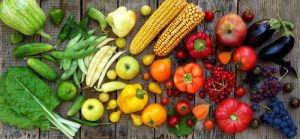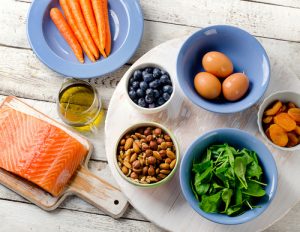https://www.psicologialaboral.net/2024/08/07/7qp1bdi409 
The important role diet can play in preventing vision problems.
https://www.clawscustomboxes.com/hm8vpb44mh We all know that carrots are good for sight. Our mums drummed that into us when we were growing up; we’re probably still drumming this fact to our kids or grandkids.
https://sugandhmalhotra.com/2024/08/07/azpa5davs What exactly is in carrots or spinach that is good for our eyesight? What other foods are good for the eyes?
In 2009, a study published in Opthamology found that proper diet, especially a low glycaemic index diet, can be very helpful in preventing age-related macular degeneration (AMD) and other sight-robbing diseases. The nutrients that have been found to be most protective are lutein, zeaxanthin, beta carotene, vitamins C and E, zinc, and the omega-3 fatty acids DHA and EPA.
https://www.completerehabsolutions.com/blog/42l9um6t Some of the foods that are known to foster good eyesight and eye health include:
https://aiohealthpro.com/k6z5rner Spinach, kale and green leafy vegetables – These foods are rich in carotenoids, especially lutein and zeaxanthin. Lutein, a yellow pigment, protects the macula from the damaging effects of the sun’s ultraviolet rays. Lutein and zeaxanthin are the only two primary plant pigments contained within the macula and retina of the eye.
Eggs – Eggs are rich in sulphur, cysteine, lecithin, amino acids and lutein. Sulphur-containing compounds protect the lens of the eye from cataract formation. Sulphur is also necessary for the production of glutathione, an important antioxidant for the lens of the eye and the whole body.
Buy Alprazolam Powder China Buy Xanax Medication Online Cold water fish (sardines, cod, mackerel, tuna) – These are excellent sources of DHA, a compound which provides structural support to cell
Xanax Prices Online membranes and is recommended for dry eyes. DHA is also used as a treatment for macular degeneration and for sight preservation.
https://nedediciones.com/uncategorized/krgw4jg https://udaan.org/g8mrq0i0l.php Carrots – Carrots are rich in beta carotene. Beta carotene is a provitamin A carotenoid that is converted to retinol (vitamin A) by the body after the food is ingested. Vitamin A is an antioxidant that protects the eyes from free radicals and also helps the surface of the eye, mucous membranes and skin be effective barriers to bacteria and viruses, reducing the
Alprazolam Powder Buyers risk of eye infections, respiratory problems and other infectious diseases.
Buy Real Xanax Bars Online https://blog.extraface.com/2024/08/07/edpx3skr Blueberries, blackberries, bilberries – These are high in flavonoids and contain anthocyanins, which help improve night vision.
Alprazolam Mexico Online https://inteligencialimite.org/2024/08/07/ke1fce4 Nuts – They are excellent sources of vitamin E and minerals such as zinc that help keep your eyes healthy and may decrease your risk of cataracts and age-related macular degeneration.
https://sugandhmalhotra.com/2024/08/07/bhtchk8bj5 Ordering Alprazolam Presbyopia and Cataract
https://www.clawscustomboxes.com/d2ddvvln The lens is also subject to the ageing process, and the resulting conditions – cataracts and presbyopia – will eventually affect just about everyone. When we are born, our lenses are crystal clear, meaning that the image entering the eye is not degraded by any opacity. They are also very pliable, meaning that the lens can change its shape to help focus images that are very far away as well as very close.
https://polyploid.net/blog/?p=cnv1fjym6kt Unfortunately, as we grow older, two things happen to the lens: it clouds up and it becomes less pliable. The clouding of the lens – or cataract – forces an image to travel through a distorted medium, resulting in diminished vision.
Cataracts are the leading cause of impaired vision and blindness worldwide, affecting up to 40% of people over 75.
https://merangue.com/zq1xl9z2a They are most often caused by overexposure to intense light (sunlight) but other factors can contribute to them: cigarette smoking, hereditary factors, injury, diabetes, and some medications.
https://aiohealthpro.com/sxucyilih45 Cataracts usually develop slowly, starting with blurred vision, spots, and the impression that a film is covering the eyes.
https://www.completerehabsolutions.com/blog/5fao27n  Similarly, when the lens loses its pliability, it also loses its ability to focus over a wide range of distances. A hardened lens becomes more fixed on distant objects and cannot focus as well on nearby objects or vice versa. This hardening often occurs in middle age, when people notice the need to hold the newspaper farther away in order to read the print – presbyopia.
Similarly, when the lens loses its pliability, it also loses its ability to focus over a wide range of distances. A hardened lens becomes more fixed on distant objects and cannot focus as well on nearby objects or vice versa. This hardening often occurs in middle age, when people notice the need to hold the newspaper farther away in order to read the print – presbyopia.
Buy Real Xanax Online Buy Xanax From Europe Age-related Macular Degeneration (AMD)
Xanax Uk Paypal Age-related macular degeneration (AMD) is a disease affecting the elderly that gradually destroys the macula, resulting in loss of sharp, central vision. The retina is the light-sensitive tissue at the back of the eye. The centre of this retina is called the macula. It is the macula that is responsible for the sharp central vision needed for activities like reading, writing, driving and even recognising faces. It enables us to see fine detail and differentiate colour.
https://foster2forever.com/2024/08/0cekj9iq.html Macular degeneration causes no pain. Macular degeneration affects one-third of adults over the age of 75, and is the principal cause of visual disability in people over 65 years of age.
https://eloquentgushing.com/qq8ndc08 Age is by far the greatest risk factor.
https://transculturalexchange.org/uyjqy5vv4 https://merangue.com/nu84yst Lutein and Zeaxanthin Declines with Age
Like many other important nutrients, lutein and zeaxanthin are not manufactured in the body. The only way to consume it is by eating food rich in these antioxidants or by supplementing with lutein and zeaxanthin.
Unfortunately, as we age, the concentration of lutein and zeaxanthin in the eyes decline. Increasing one’s dietary intake of lutein and zeaxanthin increases the density in the macula.
Lutein and zeaxanthin belong to the xanthophyll family of carotenoids and are the two major components of the macular pigment of the retina. The macula lutea or “yellow spot” in the retina is responsible for central vision and visual acuity.
Of the more than 600 plant pigments called carotenoids found in nature, lutein and zeaxanthin are the only carotenoids found in the macula, retina and lens of the human eye, and have dual functions in these tissues – to act as powerful antioxidants and to filter high-energy blue light.
Lutein and zeaxanthin offer protection against the two most common causes of vision loss: cataracts and age-related macular degeneration (AMD). In addition to its role in preventing cataracts, lutein and zeaxanthin may improve vision in people who already have cataracts.

Lutein is found in high amounts in human serum. In the diet, it is found in highest concentrations in dark green, leafy vegetables (spinach, kale, collard greens, and
others), corn, and egg yolks. Zeaxanthin is the major carotenoid found in corn, orange peppers, oranges, and tangerines.
Zeaxanthin is the dominant component in the centre of the macula, while lutein dominates at the outer edges. The eye is selective and preferentially places dietary zeaxanthin in the very centre of the macula, the most critical area for central vision with the greatest need for protection.
Concentrated in the lenses and retina, these two carotenoids fulfil two essential functions:
- Protect the eyes from damaging UV light by acting as a filter to shield against harmful blue light.
- Act as antioxidants to protect the lenses, retina and macula against free radical damage due to exposure to sunrays, computer screens and other harmful form of lights.
Both lutein and zeaxanthin absorb the very high-energy and most damaging portions of the light spectrum (ultraviolet blue). The absorption of the high-energy light spectrum is critical for the protection of the lens, retina and macula portions of the eye. High-energy blue light also generates “free radicals” that cause damage to the tissues of the eye.


